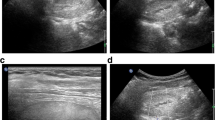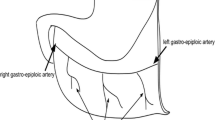Abstract
Idiopathic or spontaneous segmental infarction of the greater omentum (ISIGO) is a rare cause of acute rightsided abdominal pain. The symptoms simulate acute appendicitis in 66% of cases and cholecystitis in 22%. Progressive peritonitis usually dictates laparotomy, and an accurate diagnosis is rarely made before surgery. The etiology of the hemorrhagic necrosis is unknown, but predisposing factors such as anatomic variations in the blood supply to the right free omental end, obesity, trauma, overeating, coughing, and a sudden change in position may play a role in the pathogenesis. We present herein the case of a 37-year-old man in whom ISIGO, precipitated by obesity and overeating, was successfully diagnosed and treated by laparoscopy. Resection of the necrotic part of the greater omentum is the therapy of choice, and ensures fast recovery and pain control. Serohemorrhagic ascites is a common finding in ISIGO, and careful exploration of the whole abdominal cavity should be performed. The laparoscopic approach allows both exploration and surgical intervention.
Similar content being viewed by others
References
Epstein LI, Lempke RE (1968) Primary idiopathic segmental infarction of the greater omentum: case report and collective review of the literature. Ann Surg 167:437–443
Adams JT (1973) Primary torsion of the omentum. Am J Surg 126:102–105
Basson SE (1981) Primary torsion of the omentum. Ann R Coll Surg Engl 63:132–134
Sarac AM, Yegen C, Aktan AO, Yalin R (1997) Primary torsion of the omentum mimicking acute appendicitis: report of a case. Surg Today 27:251–253
Nihei Z, Kojima K, Uehara K, Sawai S, Kakihana M, Hirayama R, Mishima Y (1991) Omental bleeding with spontaneousely derotated torsion—a case report. Jpn J Surg 21:700–702
Wagner S, Clerici Th, Nägeli J, Zünd M, Lange J (1998) Diagnostic laparoscopy in acute pain of the right lower abdomen. In: Krähenbühl L, Frei, E, Klaiber C, Büchler MW (eds) Acute appendicitis: standard treatment or laparoscopic surgery? Karger, Basel, pp 151–158
Leitner MJ (1952) Torsion, infarction and hemorrhage of the omentum as a cause of acute abdominal distress. Ann Surg 135:103–110
Steyaert H, Valla JS (1997) Laparoscopic approach to primary infarction of the greater omentum. Surg Laparosc Endosc 7:97–98
Puylaert JBCM (1992) Right-sided segmental infarction of the omentum: clinical, US and CT findings. Radiology 185:169–172
Chung SCS (1992) Laparoscopic resection for primary omental torsion. Aust N Z J Surg 62:400–401
Author information
Authors and Affiliations
Rights and permissions
About this article
Cite this article
Goti, F., Hollmann, R., Stieger, R. et al. Idiopathic segmental infarction of the greater omentum successfully treated by laparoscopy: Report of case. Surg Today 30, 451–453 (2000). https://doi.org/10.1007/s005950050623
Received:
Accepted:
Issue Date:
DOI: https://doi.org/10.1007/s005950050623




